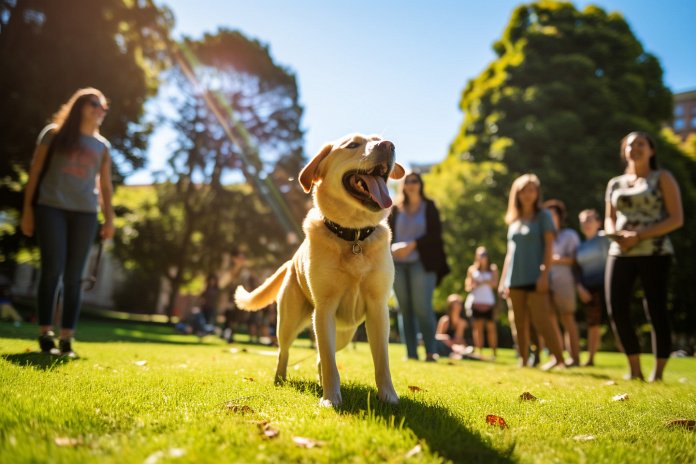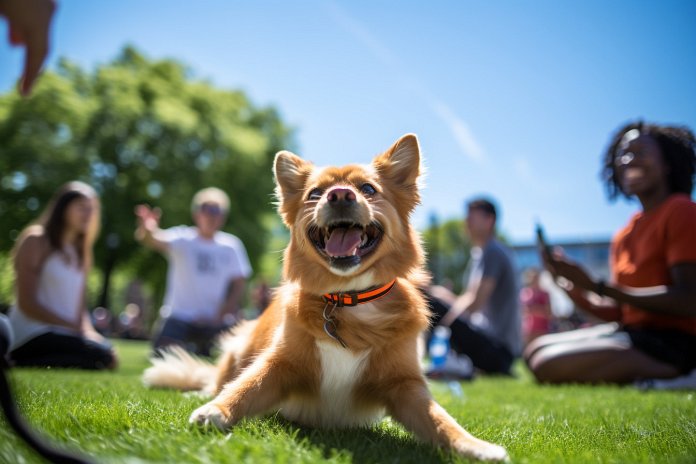
Dogs in friendly homes are comfortable around people and can sense friendliness. Body language is crucial in assessing this. A relaxed and welcoming person with a friendly voice will make a dog feel at ease. Dogs can also detect friendly pheromones and sense a person’s feelings towards them.
Signs of a Friendly Dog
A friendly dog will approach people with a wagging tail and relaxed body language. Dogs have learned to read the signs of a friendly human through body language. They will sniff and sense if a person is friendly. Some breeds, like Labradors, are naturally friendly and intelligent. Dogs can sense emotions and prefer positive feelings like happiness and calmness.
Body Language
A friendly dog may exhibit the following signs: head tilting, wagging tail, ears up, and play bowing. Other signs of friendliness include attention-seeking behavior, high energy, and positive body language.
History of Dogs Sensing Friendliness
Long ago, wolves became domesticated and broke away from the wolf pack to become dogs. This happened because dogs were able to connect with human friendliness. Dogs sought human companionship and trust was built between humans and dogs. Dogs can sense a friendly face and approach a friendly voice. For example, a Labrador named Smokey befriends hikers and follows them on their hikes.
Science Behind Dogs Sensing Friendliness
Scientists have studied dogs’ ability to accept food from friendly people and be wary of unfriendly people. Dogs can learn from inferences and respond to gestures. They can understand that patting and throwing toys are friendly gestures.
Training a Dog to Sense Friendliness
Puppy socializing and obedience training are important for teaching a dog to sense friendliness. Meeting other dogs and their owners can imprint friendly behavior on a puppy. Obedience training helps dogs recognize and respond to friendly behavior. Therapy dogs undergo training to respond to specific individuals. Retrievers, known for their desire to please, are good at learning friendly games with children. It’s important for dogs to understand who is in charge and when the game is over.
Conclusion
Dogs have the ability to sense friendliness through body language, pheromones, and the tone of a person’s voice. They can read the signs of a friendly human and respond with wagging tails and relaxed body language. Training and socialization play a crucial role in developing a dog’s ability to recognize and respond to friendliness.
“A dog’s sense of friendliness goes beyond words; it’s all about reading body language and sensing positive energy.”

Tips & Things to Know
1️⃣ Pay attention to your body language: Dogs can sense friendliness through body language, so it’s important to be relaxed and welcoming when interacting with them. Maintain a happy face and use encouraging words to make them feel comfortable and accepted.
2️⃣ Look for signs of friendliness in dogs: Friendly dogs will display certain behaviors such as bounding up to people with a wagging tail, ears up, and a relaxed body posture. They may also seek attention and exhibit positive body language. Recognizing these signs can help you gauge a dog’s friendliness.
3️⃣ Socialize and train your dog: To help your dog sense friendliness, expose them to different people and situations through puppy socialization. Obedience training can also teach them to recognize and respond to friendly behavior. Training can also help eliminate unfriendly behaviors and promote friendly interactions.
Frequently Asked Questions, Answered ✅
1. How can dogs sense friendliness in humans?
– Dogs can smell friendly pheromones and sense a person’s emotions before getting close to them.
– They can also read a person’s body language and respond to a friendly voice.
2. What are some signs that a dog senses friendliness in a person?
– A friendly dog will bound up to a person with a wagging tail and relaxed body language.
– They may also look towards their owner for approval and seek human companionship.
3. Which dog breeds are known for being friendly?
– Labrador Retrievers, Poodles, and Beagles are ranked highly on the friendly scale.
– Labradors are often chosen as therapy dogs and service dogs due to their friendliness and intelligence.
4. How did dogs develop the ability to sense friendliness in humans?
– Dogs have a long history of being domesticated and forming a bond with humans.
– They learned to read human emotions and seek companionship, which helped them become part of the human pack.
5. Can dogs be trained to sense friendliness?
– Yes, puppy socializing and obedience training can help dogs recognize and respond to friendliness.
– Therapy dogs undergo specific training to assess and respond to the needs of the person they are placed with.